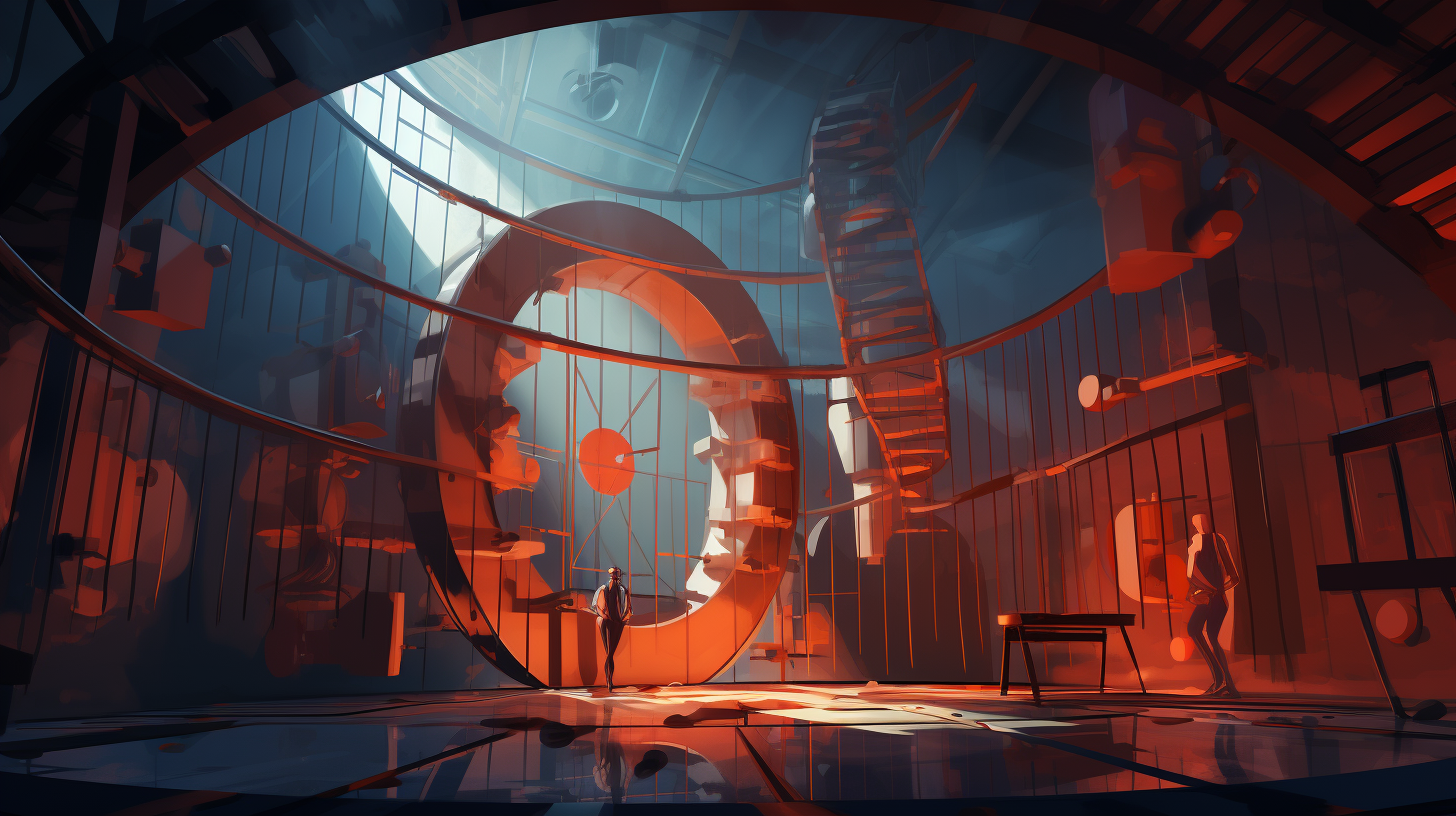Original Source: Metaverse Metaverse

Image Source: Generated by Wujie AI
In 2023, the sudden emergence of ChatGPT has ignited the entire tech industry, and various manufacturers have been laying out large models. The short-lived "Battle of the Hundred Models" is also bound to go down in history.
The intensity and speed of the AIGC outbreak are not unfamiliar to us, as the metaverse experienced a similar scene two or three years ago. Roblox became the first stock of the metaverse, Facebook directly renamed itself Meta, and various manufacturers also regarded the metaverse as the focus of their ultimate business plans. However, this year, after the new AI became the focus, the heat of the metaverse seems to have "cooled down," leading to the XR industry, which was "fighting side by side" with it, entering a cold winter.
So, is the cooling of the XR industry solely due to the "cooling down" of the metaverse? What impact does the AIGC outbreak have on it?
The "Restlessness" of Major XR Business Lines
In 2012, a VR headset called Oculus Rift was launched, which was considered to open up a new track in the consumer electronics field. Now, VR products have been known to people for over 10 years, with ups and downs in the industry, such as the rise in 2014 and rapid growth in 2015, as well as the burst of the bubble at the end of 2016.
Now, with the fading of the metaverse craze, the XR industry has also returned to calmness. Metaverse observes that the major companies that once heavily invested in the XR industry are now frequently experiencing phenomena such as layoffs and high-level executive departures.
In August of last year, Alibaba's Damo Academy XR Lab, which had been established for less than a year, experienced a high-level personnel shake-up, with its chief scientist Tan Ping and several high-level executives resigning one after another.
On February 16, Tencent's VR department, which had been established for 8 months, almost disbanded the entire business line of over 300 people. Tencent's external response was that they would change the hardware development path and no longer engage in money-losing self-research.
In May, Ma Jie, the head of the development of China's first metaverse product "Xirang," also announced his resignation.
In August of this year, iQIYI's VR company, Dream of Wonderland Technology, was reported to have stopped paying salaries and ceased operations. At the same time, its Qiyu VR products have been removed from JD.com and Taobao.
On November 7, PICO, the VR department under ByteDance, issued an internal notice announcing layoffs involving more than 300 employees. As a major player in the XR industry, PICO, backed by the giant ByteDance, has unparalleled advantages and resources compared to other manufacturers. However, any movement within the company will spread throughout the entire industry.

At the end of 2023, the turmoil at PICO undoubtedly cast a huge question mark over its own future and that of the XR industry.
Looking at the global XR industry, Apple's Vision Pro, which has been in the making for seven years, has not yet been officially launched, but its high price tag destined it to be a niche product; Meta's Quest3 had a slow start in sales, and Meta has lowered its Q4 shipment forecast by 5%-10%, expecting a 70%-80% Q1 shipment decline next year.

Metaverse believes that the recent adjustment in the XR industry this year is due to the bursting of the metaverse trend, lower-than-expected XR device sales, a complete reevaluation of the pricing model of tech companies by the capital market, focusing on profitability rather than user growth, and the global economic downturn. These factors have prompted many major companies to make strategic adjustments.
Lack of Applications, High Production Costs—Can AIGC Solve the XR Industry's Dilemma?
We believe that the XR industry is still in the early stages of development, and from the consumer perspective, it is transitioning from enthusiasts to ordinary consumers. At this stage, the characteristics of product application scenarios, hardware iteration standards, and future development directions are relatively clear. However, there are still shortcomings in terms of price, the completeness of the content ecosystem, portability, and market education in terms of experience.

Among these, the lack of ecosystem and applications is the biggest bottleneck hindering the further development of XR. We see that the number of applications in hardware is still too small, with just over 500 applications in the Quest3 store and only 50-60 applications in the Vision Pro app store, many of which are demo or early MVP.
Currently, excellent XR content is mainly concentrated in the gaming field, such as "Half-Life: Alyx" and "Resident Evil 4 VR Edition." Omdia's data shows that in 2022, the global VR content market revenue is expected to reach $3.1 billion, with VR game revenue accounting for approximately 89%. The extremely singular application scenario directly limits the industry's development, and XR needs to quickly expand into other content scenarios beyond the gaming field.

It is well known that creating an application in the XR industry is a very complex and massive undertaking because creating content in XR is difficult, somewhat similar to creating a major game. It requires the use of game engines, programmers, designers, 3D developers, sound engineers, and other technical talents, as well as a significant amount of time and money.
In this situation, if a company were to build a team to do this alone, it could lead to a huge investment with less than ideal results. However, when XR is combined with AIGC, it can freely control the system through voice or gestures, handle complex model creation and scene building through natural language, and even generate code, greatly reducing the production cost of XR content. What used to take six months to produce can now be completed in a month or even a week. Moreover, it creates a disruptive experience, just like Iron Man controlling the armor through J.A.R.V.I.S AI.

The emergence of AIGC is pushing XR applications to gradually move towards a 3D, interconnected, highly immersive direction, especially in the gaming field, where AIGC has begun to improve creative efficiency.
For example, Roblox's XR game engine has introduced Code Assist and Material Generator, AI tools that help community users improve game production efficiency. Unity also released Unity AI, an AI tool that helps developers create games faster and better.
The improvement of AIGC capabilities is driven by large models, such as language large models enhancing perceptual capabilities, visual large models enhancing cognitive capabilities, and multimodal large models enhancing creative capabilities. Some experts have indicated that large models are not only for language but also for multimodal, and in the future, there should also be large models for the metaverse, such as spatial computing large models, which are currently almost non-existent in the market and should be developed by relevant companies in the next two to three years.
In the Future, Is B2B Business Better for XR?
In recent years, with the acceleration of global digitization, emerging technologies such as AI, cloud computing, and 5G networks are deepening, and the XR industry is expected to enter a period of recovery. According to the market analysis company Frost & Sullivan, the global market size of virtual and augmented reality technology is expected to climb to $661.4 billion by 2025, equivalent to a compound annual growth rate of 86.3% from 2019 to 2025.
In the B2B market, we have seen many enterprises using XR+AIGC to improve daily management efficiency. Currently, many leading companies, including Accenture and Walmart, are using new technologies for employee training.
For example, Walmart usually needs to create many dialogue trees for training and then develop them based on the paths of each option. This process also involves creating interaction points.
Through XR devices, they can understand the strengths and weaknesses of employees during the Q&A process and provide more targeted training, resulting in greater training coverage. The flexibility of XR is not possessed by traditional pre-planned framework-based training, and trainees wearing XR headsets can complete all assessment work with the digital avatars of trainers.
The most powerful aspect of the combination of AIGC and XR in this process is personalization. Even companies with business models and organizational scales similar to Walmart cannot simply copy each other's training programs because each company has its own cultural values and business styles, which to some extent helps ensure the uniqueness and targeting of the training.
In addition to improving daily management efficiency, in recent years, XR has also been evolving in industries such as healthcare and education, helping different institutions accelerate their digitization processes.

The American AR company Magic Leap has begun to implement advanced sectors such as AR+ clinical treatment. Earlier this year, they released the industry's first AR headset that can be used in both operating rooms and other clinical environments, assisting doctors in clinical treatment by reconstructing 3D medical images and marking medical instruments.
The domestic AR smart glasses manufacturer Rokid has also started with basic sectors such as AR+ remote and medical training. Previously, doctors have been contacting remote experts through video, but this method often leads to asymmetrical remote collaboration due to uneven lighting and unclear image quality. Rokid Glass 2 allows experts to participate in diagnosis and treatment in real time from a first-person perspective, gaining a comprehensive understanding of the patient's condition.

Regarding the B2B market, the giants of the XR industry are constantly exploring new paths and new developments. At the end of 2022, Meta took the first step by partnering its VR new product, Quess Pro, with Microsoft. Microsoft's Teams, Office, Windows, and Xbox cloud gaming will all be integrated into Meta's VR headsets.
In April 2023, at the Laval Virtual conference, PICO launched a new VR headset, PICO G3, mainly targeting the B2B market in education, healthcare, training, and marketing.
Although the XR market is currently somewhat subdued, we are pleasantly surprised to find that despite the complex situation in the XR market, the entire industry and enterprises are still gathering strength and moving forward. New technologies, new products, and new applications are still constantly breaking ground, opening up new paths. It can be foreseen that as time goes on, XR will integrate with more industries and technologies to generate more solutions, empowering the digital development of various industries.
Final Thoughts
As time passes and technology develops, although the XR track may have temporarily faded, the world's leading technology companies are still preparing related technologies and products, and the market competition remains quite fierce. As an important hardware infrastructure leading to the future world, with the continuous launch of new products, XR may regain its glory at the right time and juncture.
In the book "The Inevitable" by Kevin Kelly, it is mentioned that in our short lifespan of a few decades, after experiencing the two platforms that drove social development, "PC" and "mobile communication," "virtual reality" will be the next disruptive platform. What we want to say is that no one can accurately predict the future, but the discussion about the next disruptive platform will continue.
免责声明:本文章仅代表作者个人观点,不代表本平台的立场和观点。本文章仅供信息分享,不构成对任何人的任何投资建议。用户与作者之间的任何争议,与本平台无关。如网页中刊载的文章或图片涉及侵权,请提供相关的权利证明和身份证明发送邮件到support@aicoin.com,本平台相关工作人员将会进行核查。




